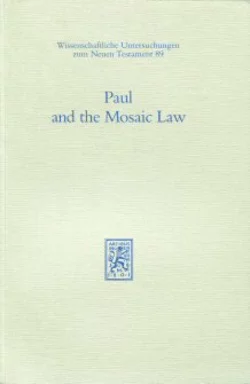This article was originally part of The Paul Page, a site dedicated to academic study of the apostle, with special focus on the work of N.T. Wright.

James D.G. Dunn, ed. (Grand Rapids, MI: Wm. B. Eerdmans Pub. Co.), 2001, 376 pp.
Though not an introductory book to the subject, nor a book for beginners, Paul and the Mosaic Law is nevertheless an indispensable work for those studying the new perspective on Paul. Originally published in 1996 as volume 89 of Wissenschaftliche Untersuchungen zum Neuen Testament, this book is a compilation of essays from the third Durham-Tübingen Research Symposium on Earliest Christianity and Judaism, held at St. John’s College in Durham in September of 1994. For this 2001 edition, the German essays have been translated into English.
Unfortunately, the editing is poor. The Hebrew and Greek are inconsistently transliterated and the book is riddled with typographical errors to the point of distraction. The English-speaking reader should also be forewarned that the non-English citations are generally not translated. Nevertheless, the book brings together essays by some of the world’s most accomplished New Testament scholars in a stimulating way. It preserves a spirited exchange between Stephen Westerholm and Heikki Räisänen, intruiging suggestions by Peter J. Tomson about Paul’s understanding of halakah for Gentile Christians, and several exegetical gems scattered throughout.
The opening essay by Hermann Lichtenberger appropriately sets the tone with a helpful survey of the law in Qumran, the Septuagint, the Pseudepigrapha, Philo, and Josephus, though his treatment seems a little choppy and all too brief. Martin Hengel immediately follows with an intriguing reconstruction of Paul’s ministry in the unknown years between Damascus and Antioch.
Graham Stanton’s essay makes some valuable points near the end, including a compelling reason to regard the “elemental things of the world” in Galatians 4:3 as the elemental pairs of Jew-Gentile, etc., rather than demonic powers.
Some of the essays are pedantic, particularly the ones providing word-for-word exegetical studies, but others are captivating. N.T. Wright argues with his usual eloquence for his view of Romans 2, almost (but not quite) convincing this reviewer that the law-abiding Gentiles in that chapter are Christians. Richard Hays’ treatment of the different aspects of law in Romans 3 and 4 is particularly good, and Bruce W. Longenecker makes some important contributions to the issue of covenant theology in his treatment of Galatians 2:15-21.
Stephen C. Barton provides a helpful political and sociological context for Paul’s effort to be “all things to all people,” pointing out that it “is by no means only a ‘missionary’ principle, as is often assumed. Indeed, its primary connotation here is a pastoral-political principle to do with compromise and self-denial for the sake of church unity” (p. 279).
John M.G. Barclay’s essay articulates the case for the “weak in faith” in Romans 14 being law-observant Christians, together with the consequent irony of the pastoral implications for the “weak.”
Finally, James D.G. Dunn concludes the volume by assessing the impact of the symposium and providing intimate glimpses into the discussions surrounding the presentation of the papers. He clarifies points of agreement, among them “that Paul’s principal treatment of the law in his letters was formulated in dialogue and dispute not with non-Christian Jews, but with fellow Christian Jews. This at once cuts the nerve of much of the charge of anti-Judaism laid against Paul” (p. 310). He also writes that “no one seemed to want to maintain that Second Temple Judaism taught the need for ‘perfection’ in law-keeping” (p. 312), though that idea is alluded to at a couple of points in the book.
Some issues are eloquently argued but ultimately unresolved throughout the volume, such as whether pistis Christou means “faith in Christ” or “faith(fulness) of Christ,” and how to balance continuity and discontinuity with reference to the law. But consensus in an exchange such as this is unlikely, and the differences are guaranteed to stimulate serious reflection.
Without a doubt, this important work belongs on the bookshelf of every student of Pauline theology. The way that the symposium brings together a diversity of viewpoints into dialogue is encouraging. It would be even more exciting, from this reviewer’s viewpoint, to see Jewish, feminist, and liberation theologians brought into the dialogue as well. Contributors from the two-thirds world (often referred to as “the third world”) in particular could help to bring some critical insights to bear on the issue of the new perspective on Paul.





